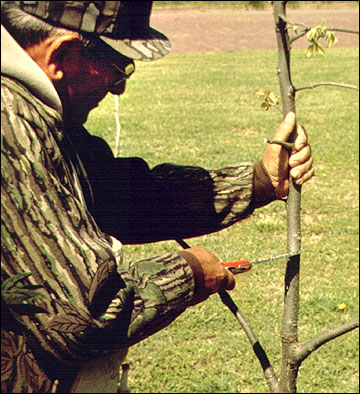Editor's note
The following abstract describes a publication that is only available as a downloadable PDF.
In Missouri, pecan and black walnut trees produce high quality nuts that are enjoyed by many people. These trees reach their full nut-bearing potential only if careful consideration is given to the rootstocks and cultivars used to establish an orchard of nut trees. To ensure top quality orchard trees, many growers choose to grow their own rootstock trees and graft those trees with superior nut cultivars. This bulletin will discuss nut tree propagation, from germinating seeds to grafting large trees. Updated in 2006, this publication gives a detailed description and photos for three grafting techniques: the three-flap graft, the bark graft and the arrowhead graft.
Seed propagation
Nut trees are easily grown from properly stratified nuts. Collect nuts for planting during the fall harvest season. Black walnuts should be hulled and washed as soon as you collect them. During the washing process, discard all walnuts that float to the top (these floaters are poorly filled and will not germinate well). Even though seed from any walnut tree can be used to grow rootstock trees, 'Kwik-Krop', 'Sparrow', and 'Thomas' nuts have proven to produce superior rootstock trees. Collect pecans as soon as they fall from the tree then soak nuts in water for 24 hours. 'Colby' and 'Giles' pecans have proven to produce excellent coldhardy seedlings. Stratify both pecans and black walnut in moist sand by placing them in layers about 3 inches deep and holding them in a refrigerator (33 to 40 degrees Fahrenheit) for 120 days. Be sure the nuts are kept moist throughout the stratification process to ensure uniform germination after planting. Three methods can be used for growing seedlings for later use in establishing a black walnut orchard:
- Growing trees in place
- Establishing a nursery
- Growing trees in containers
Growing Trees in Place
Prepare a fine seedbed in the areas you intend to plant nut tree seed. During early spring, plant 3 to 5 stratified nuts, 2 inches deep, at each tree location. Be certain to mark the area where nuts are planted and to keep the area weed-free. During the first year, select the strongest-growing tree and remove the others by cutting them off below the root collar. Fertilize the seedlings in mid-July with 1/4-cup of a slow release fertilizer per tree location. Water trees when conditions become dry.
Establishing a Nursery
Choose a deep, sandy loam soil for a nut tree nursery to facilitate digging and transplanting. Prepare a fine seed bed for the nursery area in early spring. Plant stratified seed 2 inches deep, 2 feet apart, in rows at least 4 feet apart. Keep the nursery weed-free and well watered. Sidedress the nursery rows with a slow release fertilizer in mid-July. Nursery-grown trees should be dug for transplanting in March of the following year. When digging one-year-old seedlings, be sure to dig at least 16 to 18 inches deep and preserve as many fibrous roots as possible.
Growing Trees in Containers
There are several sizes and shapes of containers that can be used for growing pecan and walnut seedlings. Choose a container with an open bottom. When placed on a screen wire bench, tree roots will grow to the bottom of the pot and then become "air-pruned." The air-pruning process prevents taproot circling — a common problem in container grown trees.

 The bark graft should be applied above the first whorl of branches.
The bark graft should be applied above the first whorl of branches.
Insert the scion between the bark and wood of the stock.
Grafting trees
Grafting is an age-old horticultural technique that can be defined as attaching a twig from one tree to the stem of another in such a way that the twig continues to grow and become a permanent part of the tree. All of the branches that grow from that twig will have the identical characteristics of the tree from which the twig was taken. Grafting a twig (the scionwood) from a tree that produces high quality nuts onto a seedling tree (the stock) is the only way to assure that your tree will produce desirable nuts.
Topics
- Nut production
Pages
- 12